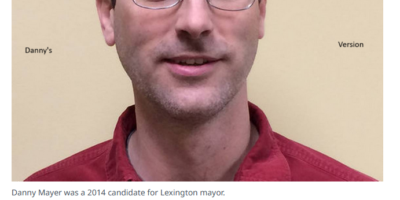UK’s statistical blame game
There’s a certain power inherent in numbers and statistics. They have a way to solidify ideas, give them density. Rhetorically, statistics are like concrete piers, heavy anchors for thought.
Take the examples of UK’s recent tuition and salary increases. Lee Todd and Public Relations Director Jay Blanton have been quick to place the proposed 6% increase in student tuition alongside declining state support for higher education and a faculty salary increase averaging 3%. UK’s anchor stat has been a comparison of the state’s 2007/08 contribution ($335.1 million) to the school’s operating budget against its 2011/2012 contribution ($303.4 million)—“an almost 10 percent decline” in state funding, the Herald-Leader duly reported on April 20.
The numbers have driven home the idea that the state has not adequately funded the university, its students or its faculty. Lack of state funding, Lee Todd and Jay Blanton and the Herald-Leader and others have determined, is largely the culprit to blame for UK’s lengthening laundry list of infrastructure, salary, educational, economic and moral woes. A Kentucky Kernel editorial went so far as directly citing an email Todd sent to students to explain her position on the imminent tuition and salary increases.
“It is going to be very difficult to provide the funds necessary to create the salary pool because we must absorb a one percent ($3.1 million) reduction in our state appropriation next year,” Todd said in the email. “With this cut, our operating state appropriation will have declined from $335.1 million in 2007-08 to $303.4 million in 2011-12 (almost 10 percent).”
The numbers as Todd and others anchor them seem to speak for themselves—a stark decline in state support over a short amount of time, all around bad shit—except of course when they don’t. Statistics are helpful, true, but we must understand their context and, at the least, consider other numerical anchors to tell other possible stories.
Context: This bubble’s a bursting
In addition to being the numerical high-point in state funding for UK, the 2007/2008 school year was also the tail end year of a gigantic global financial bubble, spurred on most visibly in the U.S. by real estate speculation and over-construction, a real mother of all peaks. The year also happened to be the first coming after Todd had released his much publicized Top 20 Business Plan. Local and national media outlets, businessmen, and administrative types, all of whom roundly applauded it, had over a year with which to advocate, with a serious Top 20 document in hand, for the state to get on board with increased funds.
Point being, 2007/2008 may not represent the best year to benchmark state support for higher education. Comparing the absolute peak days of the market to today’s depressing moment—the current not-yet-reached bottom of the worst recession since the Great Depression—seems either insane or obtuse.
A more telling statistic, taken from UK’s 2009 budget plan, compares similar numbers but instead uses a different benchmark year: state support in 1999/2000 and 2009/2010. In part, these years also capture bubble to bust territory, too—the ’99 budget came in the midst of the dot-com bubble—but because the bust plays out over ten years rather than four, the comparison tells a little different story. In 1999, the state contributed $295.3 million dollars, or 26.1% of UK’s operating budget. Ten years later in 2009, the state contributed $324.6 million—a 10.17% increase in state funding—yet it now accounted for only 13.3% of the budget.
What happened?
UK has spun these numbers to claim a lack of state support, and they’ve had support in promoting this view. Writing in an April editorial, the Lexington Herald-Leader observed “a sense almost of resignation about eroding state support. Twenty years ago, 40 percent of UK’s operating funds came from Kentucky taxpayers through legislative appropriations. By 2001 state support had dipped to 25.6 percent. It’s now just 12.5 percent” (“Mixed bag awaits UK president”).
Unfortunately for UK and the Leader, the 1999-2009 statistic suggests that the state is not quite the boogeyman it is made out to be. The state’s declining percentage as a part of university’s operating budget seems more a function of UK’s rapid—bubble-like—rise in operating costs. As a budget, UK has grown way faster than the state has been able to support.
For the state to have continued even with its support of ten years ago, 25.6% of UK’s $2.45 billion operating budget, taxpayers would need to shell out $625 million dollars a year, every year, for UK to operate at a Top 20 level—an increase of over $300 million dollars annually from present state funding. Is this what Lee Todd and public advocates of increased public support for education seriously have in mind when they complain about ignorant Frankfort politicians not showing due support?
Different stories, different anchors
UK’s increased budget is traditionally presented by Todd, Blanton and the Herald-Leader as a sign of progress and growth, but such growth is at best limited and very likely destructive.
For one, the latest budget shows that UK’s main economic burden is increased operating costs, and not declining state support. This year the state has cut $3.1 million of support but it’s the $21 million in increased operating expenses that the school really has to cover. Realistically speaking, student tuition is not paying to attract faculty, whose numbers at the college are considered ahead of schedule, according to the 2009 budget report. Nor is tuition solely covering state funding shortfalls, a whopping $3 million this year.
Increasingly, student tuition hikes are papering over increased operating expenses, which among other things cover utility costs and scholarship money (needed because of a 130% increase in tuition over the past decade). Todd doesn’t tout it so much, but there’s a good chance that the infrastructure he’s built for Top 20 status has been responsible for much of the increase in the school’s operating expenses.
The skyrocketing of operating expenses (along with capital outlays) have coincided with the college’s Top 20 push and rapidly increasing budget. In 1999, operating expenses of $420 million accounted for 37.3% of the school’s budget. A decade later, operating expenses tallied over $1.1 billion alone; they now account for over 45% of the school’s $2.4 billion dollar total budget.
These same increased operating costs seem to play a factor in limiting campus salary increases. As operating expenses have increased from 37 to 45 percent of the school’s budget, personnel costs have correspondingly decreased from 56 to 45 percent of that same budget. Over that ten years, for every $7 going to operating costs, only $5 went to personnel costs.
A pro-growth businessman, Todd charted progress in part by benchmarking operating budgets; the college’s sudden super-human increase in operating costs, from 1.2 to 2.5 billion dollars in a little less than 10 years, became a measure of excellence, a process not unlike using GDP as a gauge of economic health.
A more simple way to convey all this might be to ponder these riddles: how did it get so that a well-greased $2.5 billion dollar business organization like UK can’t muster the $12 million (0.4% of the school’s operating budget) to give some of its workers a raise, and how is it that a $2.5 billion dollar organization can’t secure the $14.2 million (0.6% of its budget) needed to spare its students a tuition increase. For the UK budgetary behemoth, these are minuscule numbers. What’s all the fuss about? Are we to believe that UK is really so efficient as to operate on margins so slim? Is UK over-leveraged, simply maxed out?




Leave a Reply